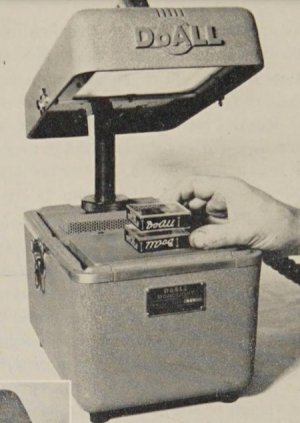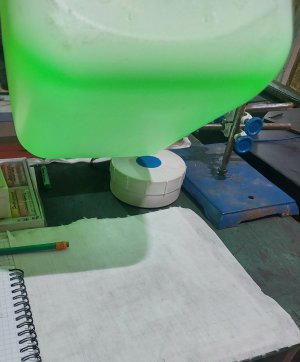A cheap green powerfull DPSS laser pointer is an excellent monochromatic source of light to use with optical flats. It has extremely narrow spectral line width (orders of magnitude better than diode lasers), it falls right into the part of the spectrum human eye is most sensitive to and it emits lots of light (1W etc).
However, the best kind of light to use with optical flats is diffuse light scattered or emmited from a large surface. See a picture of a DoAll light as an example :

The flat sheet on top is the diffuser.
So the problem with the DPSS laser is its very narrow beam width even with no lens and difficulty in expanding it (more about it later). I've previously used a red laser by removing it's lens and shining it at a white piece of paper suspended above the flat. This doesn't work with a DPSS laser. For one the beam is too narrow. Also the beam seems to reflect off white paper rather than scatter. I bought some frosted acrylic hoping to use it as a diffuser, but the beam at this intensity just passes through it with very little scattering.
The best diffuser I found is a 1L bottle made from white, non translucent plastic. I shine the laser inside at the top while holding the bottle horizontally abd the entire bottle emits very nice diffuse green glow that works beautifully with my optical flats. However, the bottle is only 3.5in in diameter. So I can't illuminate the entire one of my biggest optical flats. This makes interpreting the pattern difficult.
I saw the youtube video where a guy used a pingpong ball as a diffuser. For some reason it seems no one is selling pingpong balls around here so I can't test it. Also such a small source will suffer from the same problem (inability to illuminate the entire flat in a way that light reflects towards the user).
So, I'm looking for ideas for a better diffuser or something else that will help me to use that DPSS laser comfortably with my large 6in optical flat.
Edit: One more thing. The diffuser has to also decohere the laser beam, because if it remains coherent it produces so called speckle which messes with the observability of the fringe patterns. Typically scattering the laser light in thick plastic does that.
However, the best kind of light to use with optical flats is diffuse light scattered or emmited from a large surface. See a picture of a DoAll light as an example :

The flat sheet on top is the diffuser.
So the problem with the DPSS laser is its very narrow beam width even with no lens and difficulty in expanding it (more about it later). I've previously used a red laser by removing it's lens and shining it at a white piece of paper suspended above the flat. This doesn't work with a DPSS laser. For one the beam is too narrow. Also the beam seems to reflect off white paper rather than scatter. I bought some frosted acrylic hoping to use it as a diffuser, but the beam at this intensity just passes through it with very little scattering.
The best diffuser I found is a 1L bottle made from white, non translucent plastic. I shine the laser inside at the top while holding the bottle horizontally abd the entire bottle emits very nice diffuse green glow that works beautifully with my optical flats. However, the bottle is only 3.5in in diameter. So I can't illuminate the entire one of my biggest optical flats. This makes interpreting the pattern difficult.
I saw the youtube video where a guy used a pingpong ball as a diffuser. For some reason it seems no one is selling pingpong balls around here so I can't test it. Also such a small source will suffer from the same problem (inability to illuminate the entire flat in a way that light reflects towards the user).
So, I'm looking for ideas for a better diffuser or something else that will help me to use that DPSS laser comfortably with my large 6in optical flat.
Edit: One more thing. The diffuser has to also decohere the laser beam, because if it remains coherent it produces so called speckle which messes with the observability of the fringe patterns. Typically scattering the laser light in thick plastic does that.
Last edited:


